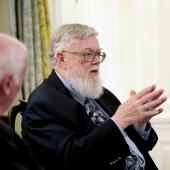
The 17th-Century Great Migration to New England and Beyond: Conventicles, Companies, Congregations, Dispersal
The participants in the 17th-century Great Migration to New England were drawn from the most committed English protestant reformers, those who most wanted the Church of England to make a full break with the Church of Rome. In this five-week course, Director of the Great Migration Study Project Robert Charles Anderson will explain the who, what, and why of the mass movement of people to New England from Old England in the 1620s and 1630s and the subsequent migrations in the generations to follow.
The colonists to New England in the early 17th century were largely men and women who began to form networks across England as early as the 1530s, meeting together in conventicles and godly households. As the decades passed, many of these reformers became more and more frustrated as one monarch after another refused to make the desired reforms. A breaking point was reached in the 1620s and a small stream of English men, women and children began to move to the New World. The pace of migration increased in the later 1630s, when thousands of migrants crossed the Atlantic each year. They were organized in companies, led by a minister or an affluent layman, based on the existing conventicles. Initially, many of the members of these migrating companies settled together in one New England town, but they soon began a process of sorting themselves out in different ways. Traces of the old English connections may still be seen decades later, even so late as the settlement of the American West two centuries on. Don’t miss this opportunity to explore the 300-year sweep of history and the context surrounding your early immigrant ancestors’ movements!
Image Credit: Seller, John, fl. 1658-1698, and active 17th century John Hills. "A mapp of New England." Map. London: And are to bee sold at his shop at the Hermitage in Wapping and by Iohn Hills in Exchange Alley in Cornhill, [1675].
Norman B. Leventhal Map & Education Center, https://collections.leventhalmap.org/search/commonwealth:3f462s90h (accessed July 23, 2024)
October 2 - Class 1: Conventicles and Godly Households, presented by Robert Charles Anderson
In the early Elizabethan years the leading reformers gathered privately, both clergy and laymen, for "prophesying," but when this was suppressed, the movement was limited to clergy. This in turn was suppressed, at which point the reformers went underground, in conventicles and godly households. This continued into the reigns of James I and Charles I and formed the basis of the Great Migration.
October 9 - Class 2: Clerical Companies, presented by Robert Charles Anderson
In some cases, a migrating company was organized around a charismatic reforming minister. Examples studied will include Thomas Hooker and the Braintree company, John Wilson and the Sudbury company, and Ezekiel Rogers and the Rowley company.
October 16 - Class 3: Yeomen's Companies and Extended Family Companies, presented by Robert Charles Anderson
More frequently, a migrating company was formed around the nucleus of a leading lay reformer. Examples will include Thomas Oliver and the Thorpe Achurch company, and Peter Noyes and the Weyhill company. These groupings may also be associated with Extended Family Companies, based largely on kinship.
October 23 - Class 4: Congregations, presented by Robert Charles Anderson
Upon arrival in New England, these companies frequently settled together in one town, which then attracted more immigrants from the same part of England. In time, these close groupings began to attenuate. The examples of the towns of Ipswich, Newbury, Dedham, Hingham, and Dorchester will be examined.
October 30 - Class 5: Dispersal, presented by Robert Charles Anderson
Echoes of Great Migration associations can be traced for generations thereafter, from Atlantic to Pacific. A brief survey will be given of migration to the Connecticut River Valley, to northern New England, then to upstate New York and the Old Northwest, and on to Utah, California, and Oregon.
